Abstract
Turnover of hepatic glutathione in vivo in the rat is almost entirely accounted for by cellular efflux, of which 80-90% is sinusoidal. Thus, sinusoidal efflux play a major quantitative role in homeostasis of hepatic glutathione. Som preliminary observations from our laboratory (1983. J. Pharmacol. Exp. Ther. 224:141-147.) and circumstantial evidence in the literature seemed to imply that the raising of the hepatic glutathione concentration above normal was not accompanied by a rise in the rate of sinusoidal efflux. Based on these observations, we hypothesized that the sinusoidal efflux was probably a saturable process and that at normal levels of hepatic glutathione the efflux behaved as a zero-order process (near-saturation). We tested our hypothesis by the use of isolated rat livers perfused in situ, single pass, with hemoglobin-free, oxygenated buffer medium at pH 7.4 and 37 degrees C. Preliminary experiments established a range of perfusion rates (3-4 ml/min per g) for adequacy of oxygenation, lack of cell injury, and minimization of variability contributed by perfusion rates. Hepatic glutathione was lowered to below normal by a 48-h fast, diethylmaleate (0.1-1.0 ml/kg i.p.), and buthionine sulfoximine (8 mmol/kg i.p.), and raised to above normal by 3-methylcholanthrene (20 mg/kg x 3 d i.p.) and cobalt chloride (0.05-0.27 g/kg-1 subcutaneously). Steady state sinusoidal efflux from each liver was measured over a 1-h perfusion, during which the coefficient of variation of glutathione in perfusates stayed within 10%. Hepatic glutathione efflux as a function of hepatic concentration was characterized by saturable kinetics with sigmoidal (non-hyperbolic) features. The data were fitted best with the Hill model and the following parameter values were estimated: Vmax = 20 nmol/min per g, Km = 3.2 mumol/g, and n = 3 binding/transport sites. The efflux could be inhibited reversibly by sulfobromophthalein-glutathione conjugate but was not affected by the addition of glutathione to the perfusion medium. The results support our hypothesis that sinusoidal efflux of glutathione is near saturation (approximately equal to 80% of Vmax) at normal (fed and fasted) liver glutathione concentrations. The phenomenon of saturability coupled with the ability to inhibit the efflux leads us to propose that sinusoidal efflux from hepatocytes appears to be a carrier-mediated process. Some recent studies by others, using sinusoidal membrane-enriched vesicles, also support these conclusions.
Full text
PDF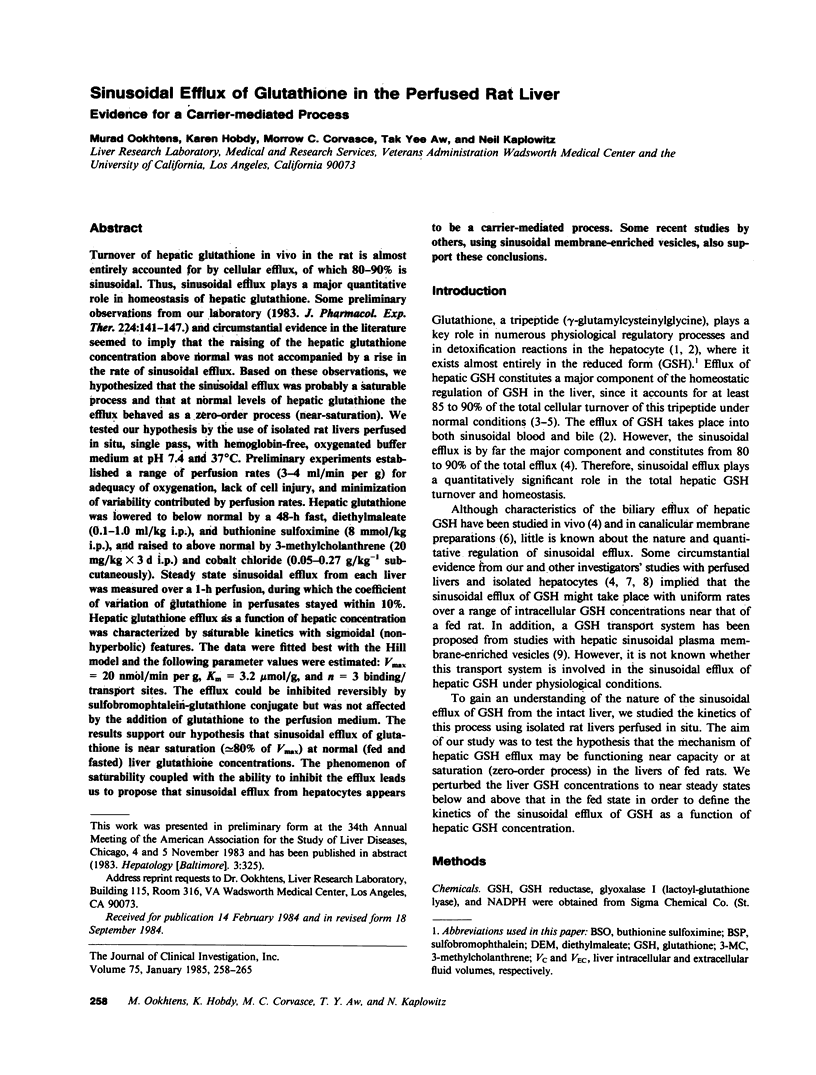
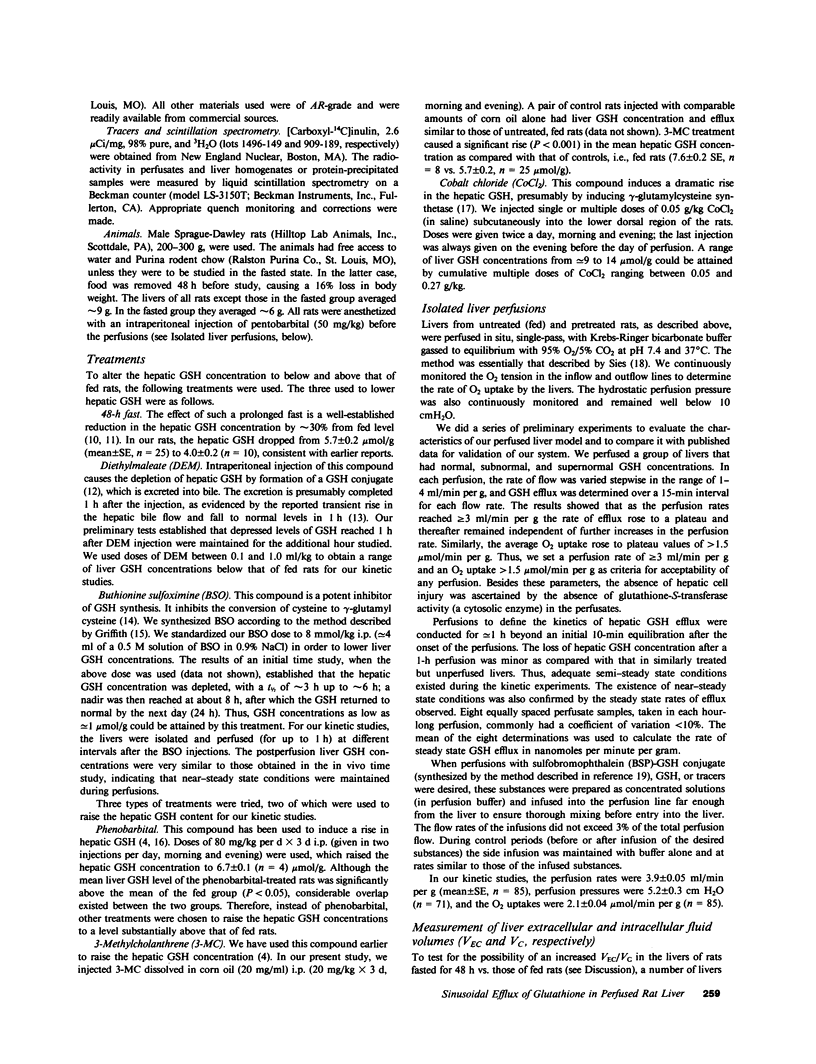
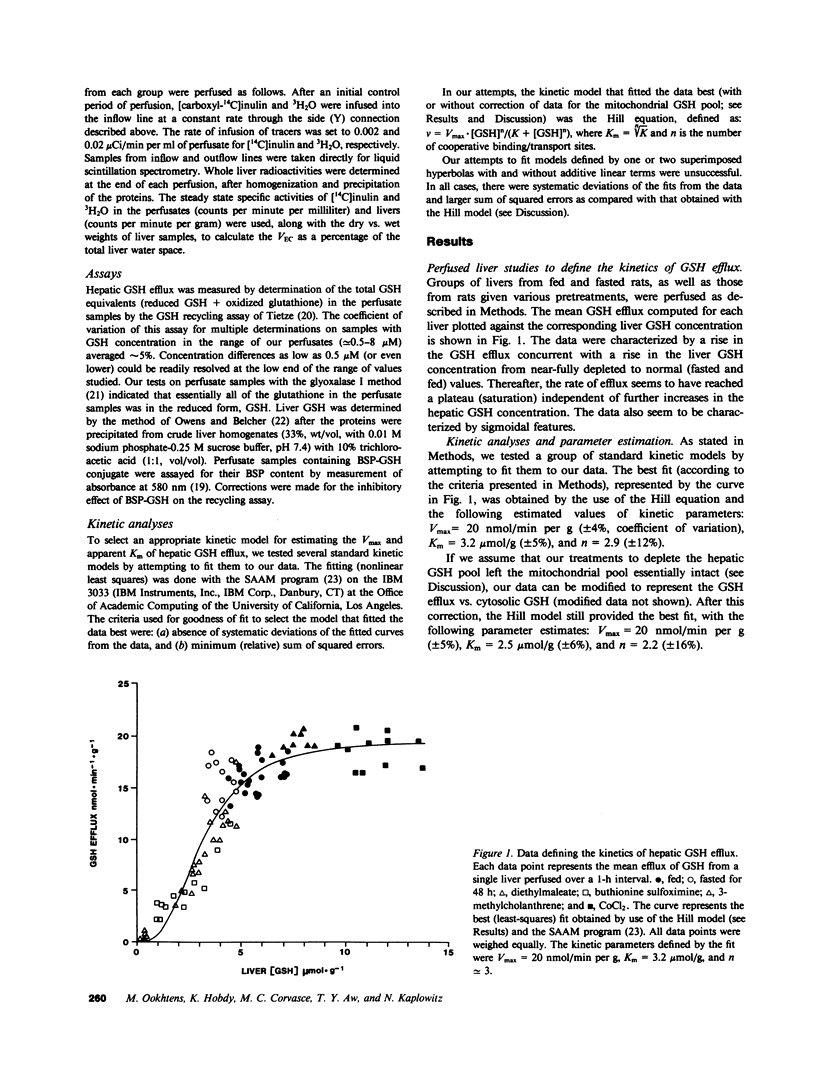
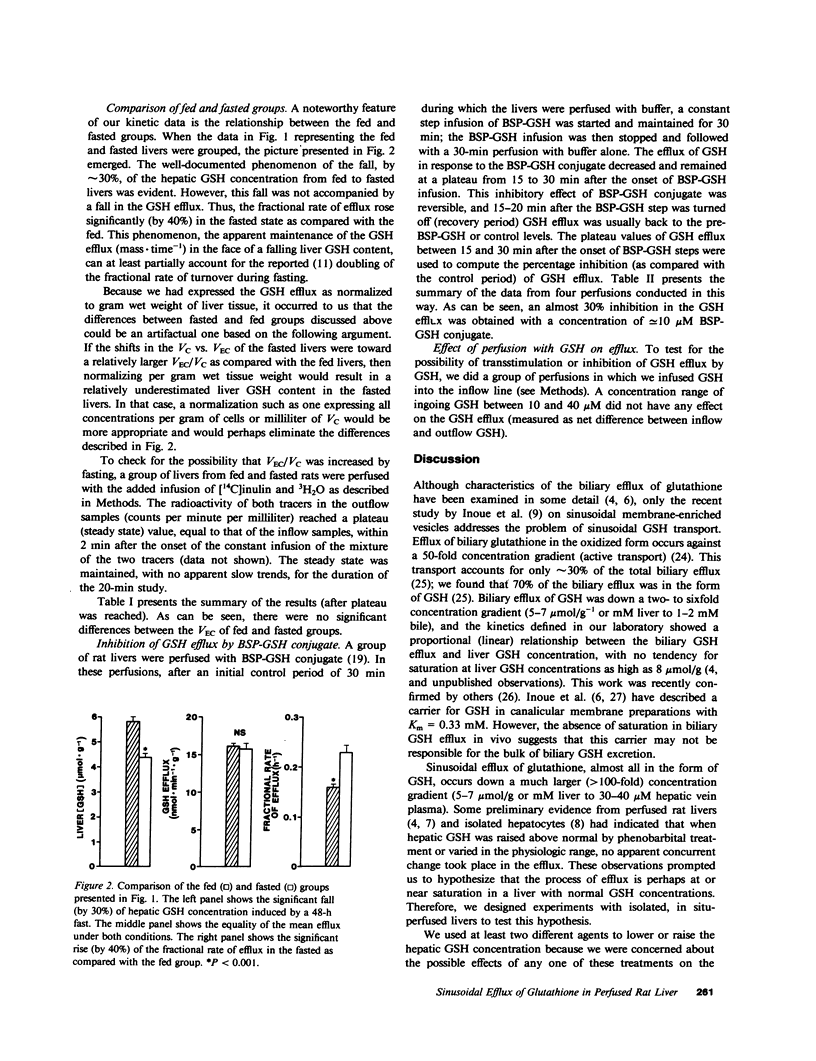
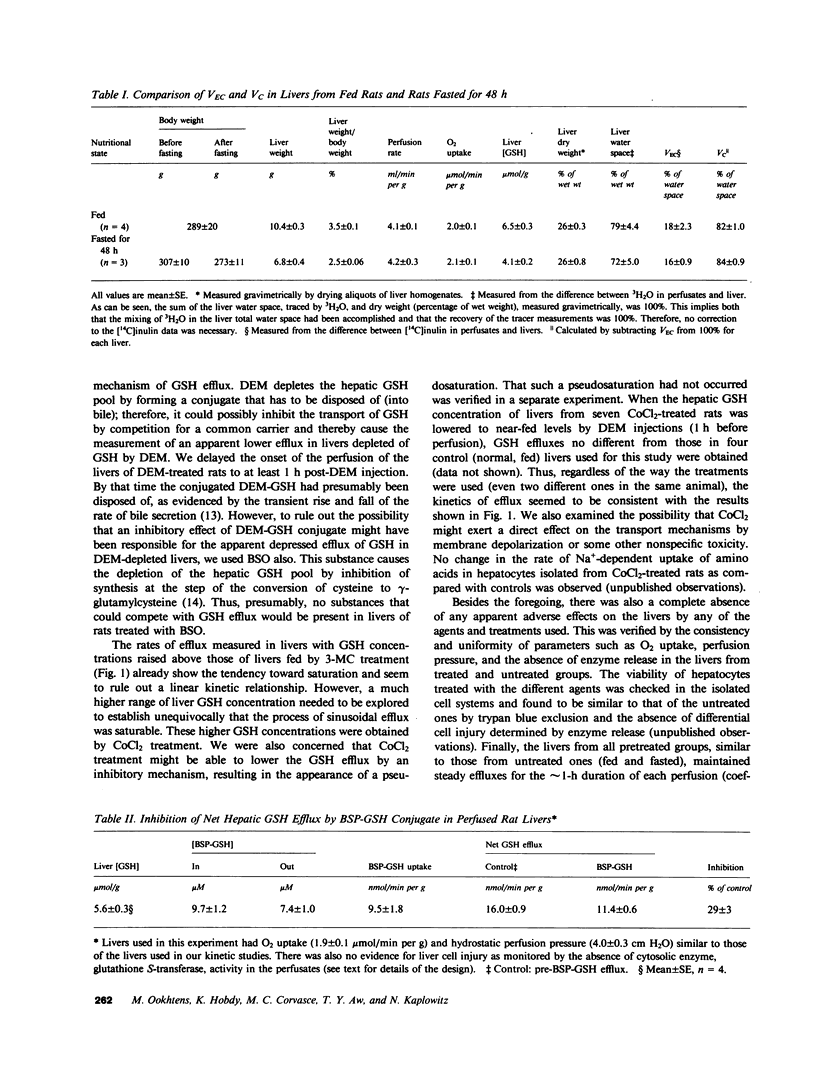
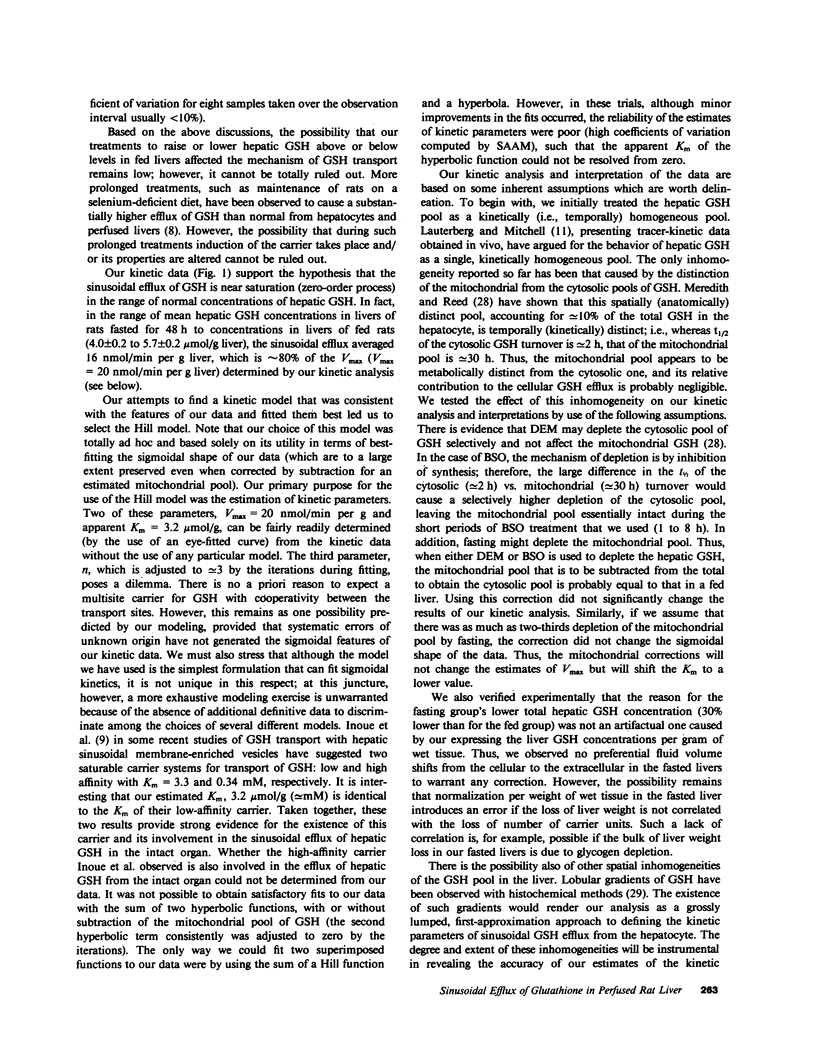
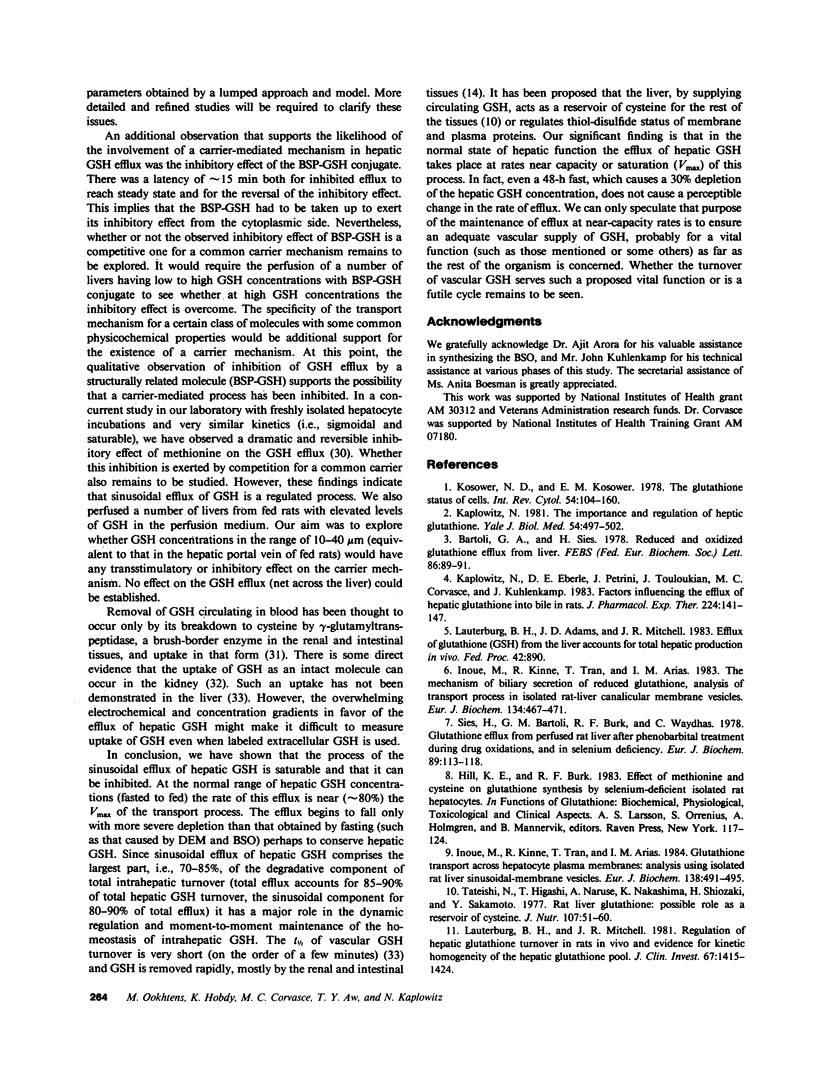
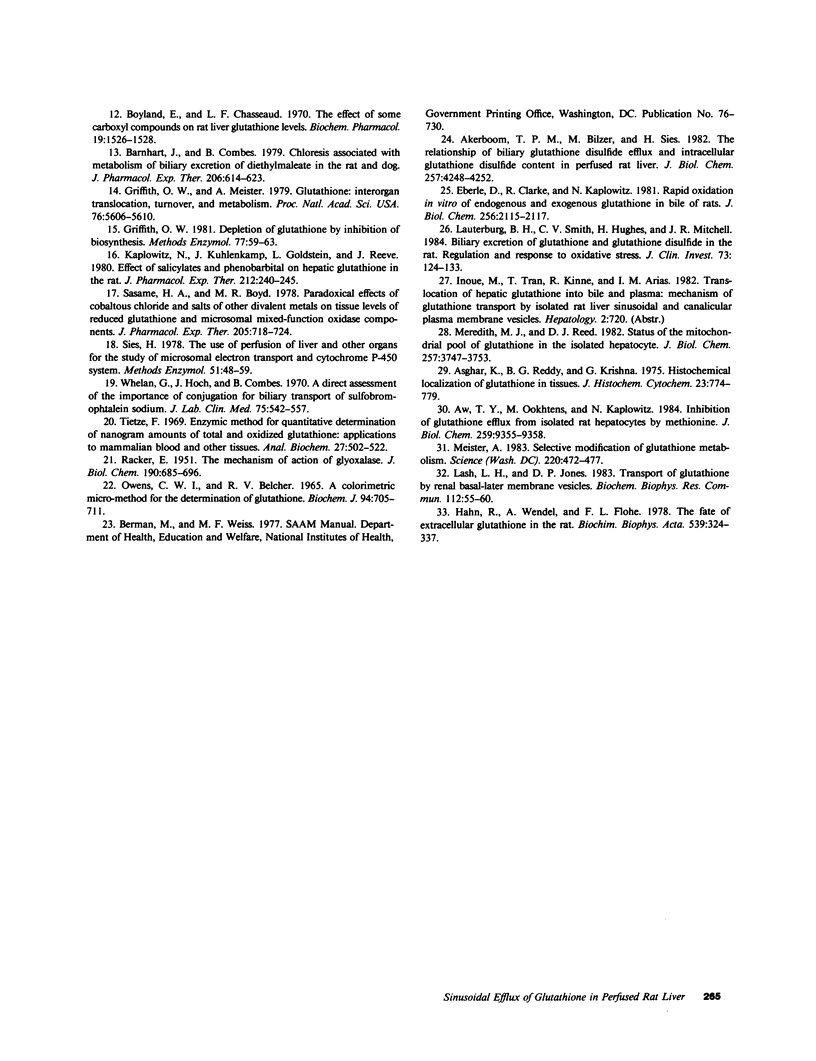
Selected References
These references are in PubMed. This may not be the complete list of references from this article.
- Akerboom T. P., Bilzer M., Sies H. The relationship of biliary glutathione disulfide efflux and intracellular glutathione disulfide content in perfused rat liver. J Biol Chem. 1982 Apr 25;257(8):4248–4252. [PubMed] [Google Scholar]
- Asghar K., Reddy B. G., Krishna G. Histochemical localization of glutathione in tissues. J Histochem Cytochem. 1975 Oct;23(10):774–779. doi: 10.1177/23.10.53246. [DOI] [PubMed] [Google Scholar]
- Aw T. Y., Ookhtens M., Kaplowitz N. Inhibition of glutathione efflux from isolated rat hepatocytes by methionine. J Biol Chem. 1984 Aug 10;259(15):9355–9358. [PubMed] [Google Scholar]
- Barnhart J. L., Combes B. Choleresis associated with metabolism and biliary excretion of diethyl maleate in the rat and dog. J Pharmacol Exp Ther. 1978 Sep;206(3):614–623. [PubMed] [Google Scholar]
- Bartoli G. M., Sies H. Reduced and oxidized glutathione efflux from liver. FEBS Lett. 1978 Feb 1;86(1):89–91. doi: 10.1016/0014-5793(78)80105-7. [DOI] [PubMed] [Google Scholar]
- Boyland E., Chasseaud L. F. The effect of some carbonyl compounds on rat liver glutathione levels. Biochem Pharmacol. 1970 Apr;19(4):1526–1528. doi: 10.1016/0006-2952(70)90075-4. [DOI] [PubMed] [Google Scholar]
- Eberle D., Clarke R., Kaplowitz N. Rapid oxidation in vitro of endogenous and exogenous glutathione in bile of rats. J Biol Chem. 1981 Mar 10;256(5):2115–2117. [PubMed] [Google Scholar]
- Griffith O. W. Depletion of glutathione by inhibition of biosynthesis. Methods Enzymol. 1981;77:59–63. doi: 10.1016/s0076-6879(81)77011-3. [DOI] [PubMed] [Google Scholar]
- Griffith O. W., Meister A. Glutathione: interorgan translocation, turnover, and metabolism. Proc Natl Acad Sci U S A. 1979 Nov;76(11):5606–5610. doi: 10.1073/pnas.76.11.5606. [DOI] [PMC free article] [PubMed] [Google Scholar]
- Hahn R., Wendel A., Flohé L. The fate of extracellular glutathione in the rat. Biochim Biophys Acta. 1978 Mar 20;539(3):324–337. doi: 10.1016/0304-4165(78)90037-5. [DOI] [PubMed] [Google Scholar]
- Inoue M., Kinne R., Tran T., Arias I. M. Glutathione transport across hepatocyte plasma membranes. Analysis using isolated rat-liver sinusoidal-membrane vesicles. Eur J Biochem. 1984 Feb 1;138(3):491–495. doi: 10.1111/j.1432-1033.1984.tb07943.x. [DOI] [PubMed] [Google Scholar]
- Inoue M., Kinne R., Tran T., Arias I. M. The mechanism of biliary secretion of reduced glutathione. Analysis of transport process in isolated rat-liver canalicular membrane vesicles. Eur J Biochem. 1983 Aug 15;134(3):467–471. doi: 10.1111/j.1432-1033.1983.tb07590.x. [DOI] [PubMed] [Google Scholar]
- Kaplowitz N., Eberle D. E., Petrini J., Touloukian J., Corvasce M. C., Kuhlenkamp J. Factors influencing the efflux of hepatic glutathione into bile in rats. J Pharmacol Exp Ther. 1983 Jan;224(1):141–147. [PubMed] [Google Scholar]
- Kaplowitz N., Kuhlenkamp J., Goldstein L., Reeve J. Effect of salicylates and phenobarbital on hepatic glutathione in the rat. J Pharmacol Exp Ther. 1980 Feb;212(2):240–245. [PubMed] [Google Scholar]
- Kaplowitz N. The importance and regulation of hepatic glutathione. Yale J Biol Med. 1981 Nov-Dec;54(6):497–502. [PMC free article] [PubMed] [Google Scholar]
- Kosower N. S., Kosower E. M. The glutathione status of cells. Int Rev Cytol. 1978;54:109–160. doi: 10.1016/s0074-7696(08)60166-7. [DOI] [PubMed] [Google Scholar]
- Lash L. H., Jones D. P. Transport of glutathione by renal basal-lateral membrane vesicles. Biochem Biophys Res Commun. 1983 Apr 15;112(1):55–60. doi: 10.1016/0006-291x(83)91796-5. [DOI] [PubMed] [Google Scholar]
- Lauterburg B. H., Mitchell J. R. Regulation of hepatic glutathione turnover in rats in vivo and evidence for kinetic homogeneity of the hepatic glutathione pool. J Clin Invest. 1981 May;67(5):1415–1424. doi: 10.1172/JCI110170. [DOI] [PMC free article] [PubMed] [Google Scholar]
- Lauterburg B. H., Smith C. V., Hughes H., Mitchell J. R. Biliary excretion of glutathione and glutathione disulfide in the rat. Regulation and response to oxidative stress. J Clin Invest. 1984 Jan;73(1):124–133. doi: 10.1172/JCI111182. [DOI] [PMC free article] [PubMed] [Google Scholar]
- Meister A. Selective modification of glutathione metabolism. Science. 1983 Apr 29;220(4596):472–477. doi: 10.1126/science.6836290. [DOI] [PubMed] [Google Scholar]
- Meredith M. J., Reed D. J. Status of the mitochondrial pool of glutathione in the isolated hepatocyte. J Biol Chem. 1982 Apr 10;257(7):3747–3753. [PubMed] [Google Scholar]
- OWENS C. W., BELCHER R. V. A COLORIMETRIC MICRO-METHOD FOR THE DETERMINATION OF GLUTATHIONE. Biochem J. 1965 Mar;94:705–711. doi: 10.1042/bj0940705. [DOI] [PMC free article] [PubMed] [Google Scholar]
- RACKER E. The mechanism of action of glyoxalase. J Biol Chem. 1951 Jun;190(2):685–696. [PubMed] [Google Scholar]
- Sasame H. A., Boyd M. R. Paradoxical effects of cobaltous chloride and salts of other divalent metals on tissue levels of reduced glutathione and microsomal mixed-function oxidase components. J Pharmacol Exp Ther. 1978 Jun;205(3):718–724. [PubMed] [Google Scholar]
- Sies H., Bartoli G. M., Burk R. F., Waydhas C. Glutathione efflux from perfused rat liver after phenobarbital treatment, during drug oxidations, and in selenium deficiency. Eur J Biochem. 1978 Aug 15;89(1):113–118. doi: 10.1111/j.1432-1033.1978.tb20902.x. [DOI] [PubMed] [Google Scholar]
- Sies H. The use of perfusion of liver and other organs for the study of microsomal electron-transport and cytochrome P-450 systems. Methods Enzymol. 1978;52:48–59. doi: 10.1016/s0076-6879(78)52005-3. [DOI] [PubMed] [Google Scholar]
- Tateishi N., Higashi T., Naruse A., Nakashima K., Shiozaki H. Rat liver glutathione: possible role as a reservoir of cysteine. J Nutr. 1977 Jan;107(1):51–60. doi: 10.1093/jn/107.1.51. [DOI] [PubMed] [Google Scholar]
- Tietze F. Enzymic method for quantitative determination of nanogram amounts of total and oxidized glutathione: applications to mammalian blood and other tissues. Anal Biochem. 1969 Mar;27(3):502–522. doi: 10.1016/0003-2697(69)90064-5. [DOI] [PubMed] [Google Scholar]
- Whelan G., Hoch J., Combes B. A direct assessment of the importance of conjugation for biliary transport of sulfobromophthalein sodium. J Lab Clin Med. 1970 Apr;75(4):542–557. [PubMed] [Google Scholar]


